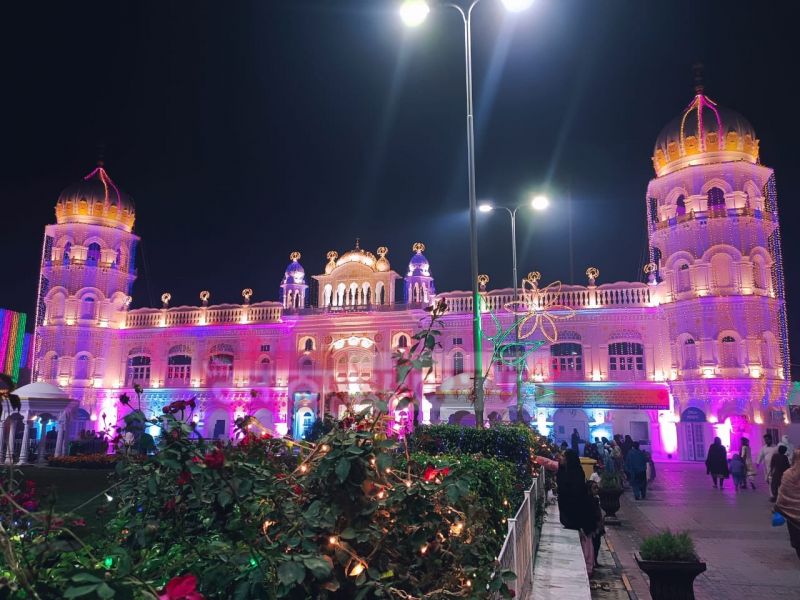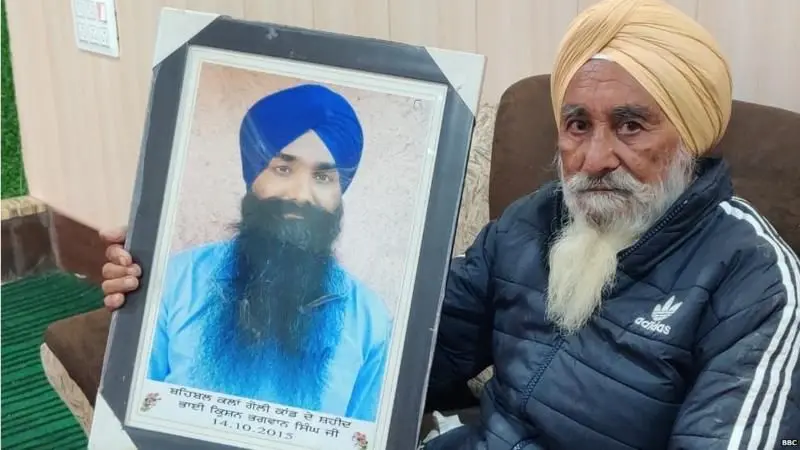.jpg)
Gurudwaras : An Introduction
A Sikh temple or shrine is called a Gurudwara, that is, the House of God, the House of the Guru, where the Guru dwells. Its most essential element is the presence of the Guru. According to the Sikh faith, while prayers to God can be offered any time and anywhere, a Gurudwara is built particularly for congregational worship. Even a very small group of devotees inhabiting any place anywhere in the world would generally build a temple for them all to get together for religious or even for social purposes. The building could be as simple as a temporary shack or a small room in a house, depending on the resources of the local community. But the Sikhs would not stint in this matter, and they have, therefore, built beautiful and imposing gurdwaras some of which can accommodate hundreds of devotees. Most of their important shrines are connected with the ten Gurus or have other historical association and are great centers of pilgrimage. It is expected of every Sikh that he would go to the gurudwara daily and join the congregation or Sangat for prayers. The Sangat is imbued with the love of God, and Sri Guru Granth Sahib presides over the congregation. The Sangat thus exercises a benign influence on those present. One-can recite the Granth Sahib at home all by one self, but then one misses the benediction of the congregation. In the gurdwaras, Sri Guru Granth Sahib, draped in fine raiment, is placed on a palanquin, often flower-bedecked, and under a canopy. The devotees, as they come, kneel before -the Granth Sahib, the forehead touching the ground, place a small offering, generally some coin, and take their seat on the carpeted floor. The morning service begins before dawn, with kirtan, the singing of hymns from Granth Sahib to the accompaniment of instrumental music, recitations from the holy book and katha exposition of the scripture, forming part of the program. At the end, the entire congregation stands with hands folded and the priest recites the Ardas, literally meaning a humble petition or prayer, concluding with a supplication to God, seeking His grace for the good of all mankind. The Ardas recalls the blessings of the Gurus and the sacrifices made by the community in the course of its history. At the end of the service, prasad or sacrament, generally a preparation of wheat flour, ghee and sugar, is distributed. The gurdwaras are open to all communities and castes and no purdah is observed. In the House of the Lord, all are equal; irrespective of their status in the world outside. On a visit to the temple, the head is to be kept covered as a mark of respect to the Granth Sahib, and shoes are not allowed inside. Smoking is taboo, and so also are liquor and other intoxicants. There is no hereditary priestly class among the Sikhs. Anyone could work as a priest in a gurudwara or function as such on a given occasion. Any layman who can read the Granth Sahib can conduct even ceremonial rites, such as on the occasion of a marriage. All gurdwaras however employ priests, called granthis, so that someone can devote all his time to the upkeep of the temple and to routine duties. The priest is expected to be well up with the scriptures, Sikhs recognise no hereditary class of people for performing kirtan in the shrines. There are persons who train themselves for kirtan and are employed for the purpose, but, often enough, even this duty is attended to by men and women from various other walks of life. Important gurdwaras run a langar or a free community kitchen for pilgrims, travelers and others. The institution of langar came into being almost with the inception of the faith. Guru Nanak organized one at Kartarpur, where he settled down during the later part of his life. The third Guru Amar Das, made it obligatory for anyone coming to meet him for his divine darshan to partake of the meal in the common kitchen. Everyone, high or low, including Emperor Akbar, did that. The langar obliterated all distinctions of the rich and the poor, and of caste and creed, and promoted equality, brotherhood and social integration. On a visit to an important shrine, it is an act of piety for a devotee to put in some manual labor in the kitchen, to serve the meals and to take the food, sitting in a row on a mat. The food is traditionally vegetarian. Service of the congregation by all means is highly prized, the more the menial, the more the spiritually edifying. Even well-to-do people would consider it an honor to wipe the dust off the shoes of the devotees, and to sweep up the shrine to imbibe a lesson in humility and service. Gurdwaras generally have provision of the lodging of pilgrims. In a town with a gurudwara, any traveler can normally hope to find some food and a place to rest his tired limbs for a night or even longer. For the Sikh community; a gurudwara is not just a place of worship, it is a social institution as well. The shrines have funds at their disposal, built out of special donations made by the people and fr6m day-to-day offerings. Some big shrines have large incomes and properties attached to them. Several educational and other institutions are run with the help of these funds; some of the schools function on the gurudwara premises. Often, marriages and various other ceremonies are performed in the shrines. In earlier days, many a decision affecting the social and political -life of the community used to be taken in the gurdwaras through a consensus of the sangat; These decisions, called gurmattas, were of a binding character, and a member of the community would think twice before violating them. Many important decisions were taken at the Akal Takht in Amritsar. There are four other historical shrines, given the status of Takhts (literally thrones) where the decisions taken by the sangat had great importance. These are Harmandir Sahib, Patna Keshgarh Sahib, Anandpur Damdama Sahib, Talwandi Sabo Hazur Sahib, Nanded (Maharashtra). Most of the important historical Sikh shrines in Punjab are managed by the Shiromani Gurudwara Prabandhak Committee, a statutory body elected from amongst the members of the community. The other gurdwaras also generally have locally elected and registered managing committees. The community had, however, to undergo great suffering to acquire the control of these shrines in its own hands. In the last century, a hereditary group of priests or mahants had entrenched themselves in these shrines, and they were treating them as their personal property. The large income from the lands attached to the shrines and the offering of the devotees was used up by the mahants in pursuit of pleasures of the flesh and in debauchery. Even in matters of prayers, they had introduced idolatry and other practices contrary to the basic tenets of the Sikh faith. A movement for the reform of the gurdwaras and their management was, therefore, launched. The British rulers backed the mahants and their vested interests. For the Sikhs, the rescue of the gurdwaras from the clutches of the mahants was a matter of survival of the faith, and in this struggle they had to bear the wrath of both the alien rulers and the corrupt, demoniac priests A non-violent campaign had to be launched by the Sikhs in Amritsar, Nanakana Sahib and elsewhere. Thousands were beaten up mercilessly by the hired toughs of the mahants and the police. Several people laid down their lives in the struggle but the movement succeeded eventually in the vesting of the management in the hands of the community. A gurudwara can be spotted from a distance by the yellow triangular flag hoisted from a pole in the compound. The flag is called Nishan Sahib. The buildings of the Sikh shrines are basically simple in their structure, the main requirement being that of a room in which Sri Guru Granth Sahib can be placed and some people can be seated as a congregation to listen to the readings from the holy book and to sing and recite its verses. Most of the historical gurdwaras were built first towards the end of the 18th century and in the 19th century when the Sikhs had gained political power in Punjab. That led to the construction of some impressive shrines. Some of these have been rebuilt in recent years, with an extensive use of marble for embellishment and durability. While among the Sikh temples, the Golden Temple of Amritsar alone rises like an island in the midst of a large tank, the structure of this temple itself has provided a model and an inspiration to builders of other shrines. Many of them are two storied, with the main roof being common to the two floors. The first floor has a gallery in the middle, overlooking the hall below, and it is supported by four or more columns and the outer walls. On the ground floor, in the space thus marked out by the four columns, or approximately in the center, Sri Guru Granth Sahib is enshrined on a platform or a movable palanquin with a canopy above. The congregation occupies the remaining space. On the top, a dome is always there, specially on older historical shrines. It is mostly white, and sometimes gilded, as in the Golden Temple of Amritsar, Tarn Taran and Sis Ganj, Delhi. Apart from the big central dome, there are often four other smaller cupolas, one on~ each corner. Several turrets decorate the parapet. The big domes are always ribbed or fluted and have usually an inverted lotus symbol fashioned out at the top At the bottom, one may come across floral or other artistic designs. Starting with a wide base, the domes reach the maximum circumference when they are less than half way up. On the pinnacle is a kalas, a short, straight, cylindrical -construction with often some concentric circles and a very small canopy at the absolute top, pendants hanging at the outer rim. The temples have entrance from all sides, signifying that they are open to all without any distinction whatsoever, and that God is omnipresent. Where space --shortage does not make it possible to provide entrances from all the four sides, as in Sis Ganj Delhi, the style could be different. From the first floor, generally, windows bulge out on all sides, supported on brackets, and on their top are shallow elliptical cornices. Many temples have a deorhi through which one has to pass before reaching the -shrine proper: They are often impressive structures with a high gate and sometimes accommodation for office and other use. From the deorhi one gets the first glimpse of the sanctum sanctorum. In their architecture, the gurdwaras owe much to the Mughal style as the artisans of the day in Punjab were trained that way. However, in course of time, they developed certain prominent characteristics, such as the repeated use of chhatris and ornamenting of parapets, corners, angles and other permanent projections. Over the door-ways, florid ornamentation is sometimes to be found. In some of the temples, more especially in the Golden Temple, Akal Takht and Baba Atal at Amritsar, the shrine at Tarn Taran and Baoli Sahib at Goindwal, artists have provided decorative embellishment through various disciplines. One type of artistic endeavor lies injaralkari or in-lay work studding of precious and colored stones into marble slabs. The slabs often have florid or simple borders and sometimes flowery designs into which stones are in-laid at appropriate places. Workers in metal emboss pictures and other designs on copper or other metals. But much of the artistic execution is by naqquashs with gach, a sort of gypsum. Beautiful designs are made on the walls with gach and then covered over with gold leaves. This work can be seen in plenty in the first story of the Golden Temple and over Har-ki-Pori, Amritsar. Verses from the Granth Sahib have also been engraved in the same style. In this ornamental gach work, cut glasses, colored as well as mirrored, and at times precious stones, are also set in. This is called tukri work. Frescoes are to be found in some of the shrines and they depict generally episodes from the lives of the Gurus. Vines, plants, flowers, birds -,and animals also figure therein. The largest number of such frescoes is on the first floor of Baba Atal. In a staircase in the Golden Temple is one fine painting of Guru Gobind Singh, riding horse and accompanied by some of his followers CONDUCT IN A GURUDWARA The conduct in a Gurudwara is similar in it's sanctity to the holy shrines of other world religions, there are certain observations which must be considered regardless of rank or status. PLACES IN A GURUDWARA. THE SACHKHAND. Sachkhand actually refers to a level of spirituality, literally it means the realm of truth, but refers commonly to the holiest room within a Gurudwara. The Sachkhand in a Gurudwara is the room where the holy scriptures are housed during the night. At the end of the day, the Guru Granth Sahib is made to rest in the Sachkhand. Anyone entering the Sachkhand would have had a bath prior to entering the Sachkand - thereby insuring cleanliness. The head must always be covered in the Sachkhand and shoes obviously removed. The Sachkhand is normally situated in the highest point in the Gurudwara - most often it is a separate room within the Darbar. THE DARBAR. The Darbar is the main hall in the Gurudwara, it is here that all ceremonies are performed. Shoes must be removed and the head covered. The behaviour inside the Darbar must reflect utmost respect. Inside the Darbar, there is a stage or platform on which the Guru Granth Sahib is placed, it is covered by a sheet of cloth known as an Armala. There is a canopy above the scriptures. There is normally another platform - placed lower than the Guru Granth Sahib. This is the main stage and all speeches, narration and kirtan is performed from here. Devotees enter the Darbar and walk towards the Guru Granth Sahib. When the devotee is before the Guru he or she should place any offerings before the Guru, these offerings might be of money, food or even a cloth (from which an Armala would later be made). Following that, the devotee would bow down before the Guru, his knees on the floor and his forehead on the ground. After that, he would take his seat on the floor - on the respective side of the Darbar. THE LANGAR. One of the halls within a Gurudwara is the Langar Hall. This is the room where Langar is distributed, it will typically contain a kitchen where the langar is prepared. Traditionally, Sikhs sit on the floor - with men and women seated on separate sides, however, many Gurudwaras in the Western world have seats and tables arranged for seating, this is as a result of Western influence. THE DAILY FUNCTIONS. The daily function of a Gurudwara usually begins early in the morning, the exact time is not dictated, in some cases this might be 2 o'clock, in others it might be 10 o'clock. The Guru Granth Sahib would be brought down from the Sachkhand and a ceremony known as the Parkash is performed, this refers to the 'opening' of the holy scriptures. Throughout the day, Gurbani might be read, there would normally be a sevadar in the darbar who serves the Karah Parshad to visitors. The Granthi would be available to read the Hukamnama - the Guru's command to the visitors. In the evening, the Rahiras Sahib is read aloud and this might typically be followed by kirtan and katha - the translation of shabads and historic/scriptural narration. The evening ends with a ceremony known as the Sukh Asan, during this, the Guru Granth Sahib is closed and laid to rest in the Sachkhand. THE GURUDWARA COMMITTEE. Previously - in the subcontinent - the Gurudwaras were run in their entirety by the sangat, there was later recognised - the need for a group of individuals ultimately responsible for various functions relating to the running of the Gurudwara, e.g., treasury, admin. Hence the Gurudwara committees were formed, these are normally elected by the sangat. The existence of such a committee is purely as a function of administration and it does not warrant a superior right within the Gurudwara. THE GRANTHI The Granthi can perhaps be best described as the 'priest' - although such a priest system does not exist in the Sikh faith. The Granthi is the custodian of the scriptures and is ultimately responsible for performing the daily ceremonies inside the darbar. The Granthi is usually appointed by the Gurudwara's committee. His (or her) typical duties might include performing the two ceremonies of Parkash and Sukh Asan, reading the Hukam nama aloud to members of the sangat during the functions and at relative times in the day, performing kirtan and katha and reading certain banis to the sangat - such as the Rahiras and morning Nitnem.










